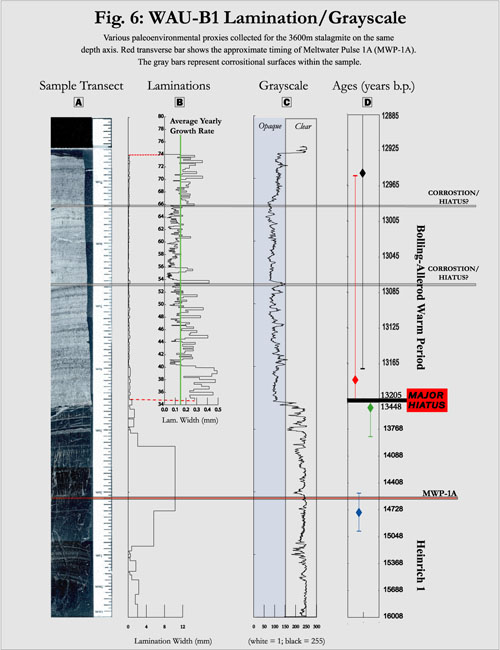

A uranium-series dated stalagmite from Lost Dog cave (3600m) within the Sarawaget Mountain range of Papua New Guinea (PNG) provides new insight into abrupt, tropical climate change during the time of global glacial decrescendo (16.0-13.0ka) Our stalagmite contains two very different calcite fabrics-composed of older columnar calcite and younger microcrystalline calcite, separated by a visually distinct growth hiatus-suggesting that the sample contained an embedded climate signal even before analysis began. We used techniques from petrology, stable isotope chemistry, and dendrochronology, to test its suitability as a paleoclimate record. When coupled with U/Th dates, our analysis suite shows that deposition switched from columnar to microcrystalline fabric between 13-14 kya. The microcrystalline section contains millimeter-scale laminations that layer counting and U/Th dates suggest are annual features.
Assuming that our sample is in some way connected to climate change occurring outside the cave, the shift in fabric theoretically represents a record of this change. The key challenge is to determine whether these changes reflect regional or global climate forcing effects over the cave. Due to the elevation, position, and timing of calcite deposition in our sample, two primary scenarios exist. The high elevation of the cave and the descent of PNG’s glaciers during the deglaciation make it possible for mountain glaciers to control fabric growth. This hypothesis is not favored, however, because of inconsistency in several regional glacial proxies.
Rather, we propose that the hiatus and subsequent onset of the banded fabric is connected to the initiation of the Australian Northwest (NW) monsoon-a system that had been suppressed during the preceding glacial period-over the site between 13-14kya. The modern NW monsoon brings heavy precipitation to the PNG highlands during the Austral summer. This interpretation is supported by a variety of other local and regional climate proxy indicators including charcoal, paleo-vegetation, and paleo-discharge records. Spectral and wavelet analyses of a microcrystalline grayscale transect are dominated by cycles similar to those seen in other modern ENSO and monsoon indices. This provides further support for the strength of our record’s climate recording abilities during an important, though poorly understood, time in earth climate history.
 |
 |
Go to Science Research Projects.
Go to Learning Objectives of Research Project.
Return to E&ESJ home page.
Last updated: 8 January 2001, KAK.